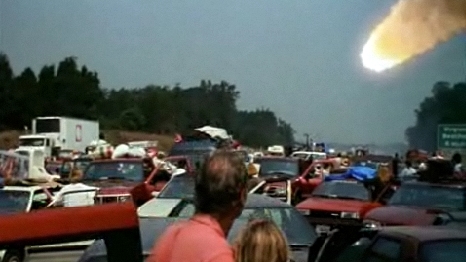In the movie Deep Impact, a dignified black president broadcasts a moving “goodbye” to the people of Earth as a long-feared asteroid casts doomsday’s shadow on the planet.
Back here in the real world, last Sunday, life wasn’t exactly imitating art. Instead, the President-Elect was whinging to the world about Meryl Streep as an asteroid, discovered only hours before, hurtled past Earth, missing by a cosmic hair. Indeed, had Trump known about it, he doubtless would have blown the asteroid off as “overrated”.
And he wouldn’t have been too far off the mark. Asteroid 2017 AG13 was only about the size of a 10-story building, as big as the rock that exploded above Chelyabinsk, Russia in 2013, breaking windows and popping a few eardrums, but not big enough to cause widespread destruction. But the failure of NASA and other sky watchers to notice it until the very last moment puts paid to the myth about asteroid strikes – that astronauts will have plenty of time to lasso the big booger while the worst we’ll suffer here on the ground is jerks who honk during traffic jams.
While NASA and others do an admirable job of convincing us that an extinction-event asteroid strike is unlikely, their own data tells us they have no right to be so cocksure.
“As of 2016, the number of discovered near-Earth asteroids totalled more than 15,000. An average of 30 new discoveries are added each week. The 15,000 milestone, reached on October 13, 2016, marks a 50 percent increase in the number of known near-Earth asteroids since 2013, when discoveries reached 10,000 in August of that year.”
In other words, just three years ago, there were 5000 near-Earth asteroids we didn’t know about. And how big were they?
“Roughly half of the known catalogue of NEOs are objects larger than about 460 feet (140 meters) in size. The estimated population of NEOs of this size is about 25,000. Current surveys are finding NEOs of this size at a rate of about 500 per year.”
That’s an estimated 10,000 potentially catastrophic asteroids that won’t be crossed off the “terrorist” list for another 20 years, a projection that makes Islamic State seem like an outbreak of acne on the eve of a fight against Mike Tyson.
“It seems as if the whole cosmos is trying to snuff us out,” wrote Philip Plait in his book, Death from the Skies!: The Science Behind the End of the World. “In a sense, it is – there’s danger aplenty in the Universe – but we have to take a practical view here. We have to appreciate the vastness of space and time, and our ability to manipulate events around us.”
That’s true. But, assuming the asteroid can be detected, the variety of strategies to deal with the threat, with their talk of lasers, ion drives, squadrons of “smart” killer satellites, giant paintball guns and enormous games of scissors/paper/rock, will probably remain the stuff of science fiction for the next two decades at least. The most popular and realistic defence remains the old nuclear weapon scenario, with a rocket-propelled missile either deflecting the monster or destroying it completely.
Should that day ever come, we might well have to say that humanity was saved by the most reviled weapon in history, delivered to its target thanks to technology first championed by the most hated man the world has ever known.
The message there might be to have a little patience with the people and things that seem to scare us to death.







